Two Fly Nymphing: Testing Flies, Determining Depth and Casting
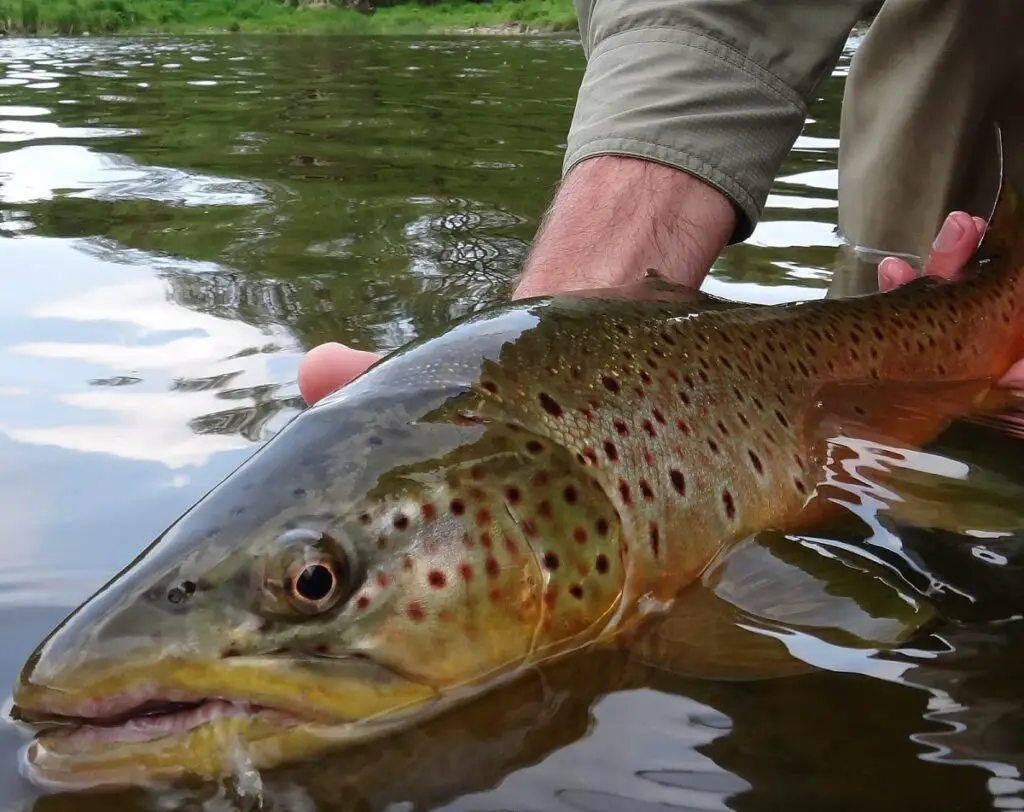
Those who know me know that I guide for a living and that my specialty is nymphing. I nymph fish all year for trout, steelhead, and salmon in my local rivers. I am almost always doing two-fly nymphing because of how much more effective it is.
I use two nymphs at a time because I can cover two sections of the water column which helps me determine if the fish are feeding high or low. Two flies also allow me to test and determine which flies the fish want.
Two flies also almost ensures that at least one of the flies will be perfectly in position and in the strike zone.
I will discuss my methods for determining feeding zones and testing out flies and show you my most effective two-nymph rig.
Testing Flies
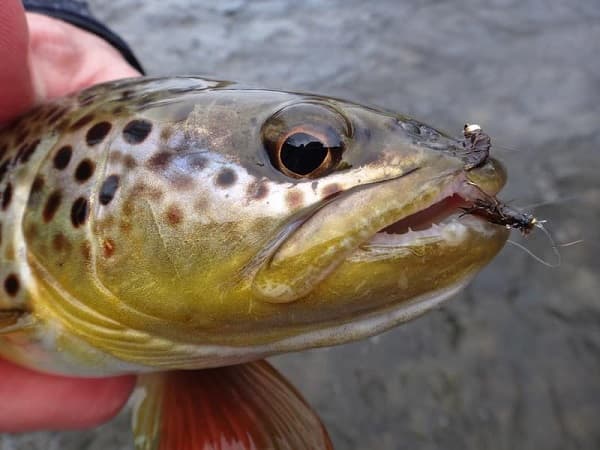
You can place your flies anywhere on your leader. However, my flies are rarely in random spots.
There two flies on the leader are the primary fly, which is on the bottom, and the secondary fly, which is up the leader. Some might call these the point fly or lead fly, and the dropper fly or tag fly.
My primary fly is my confidence fly. This is the fly that I’m guessing will be the most effective.
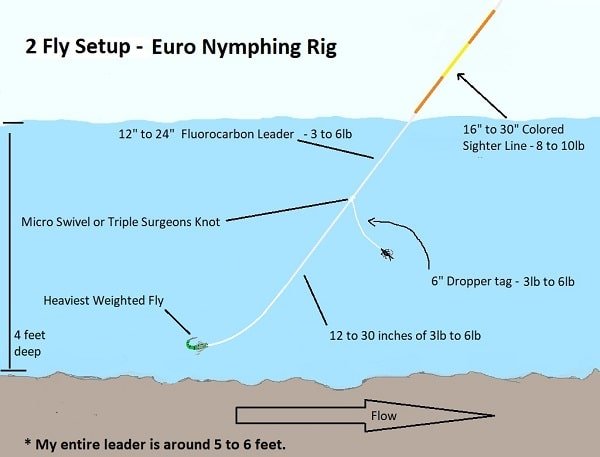
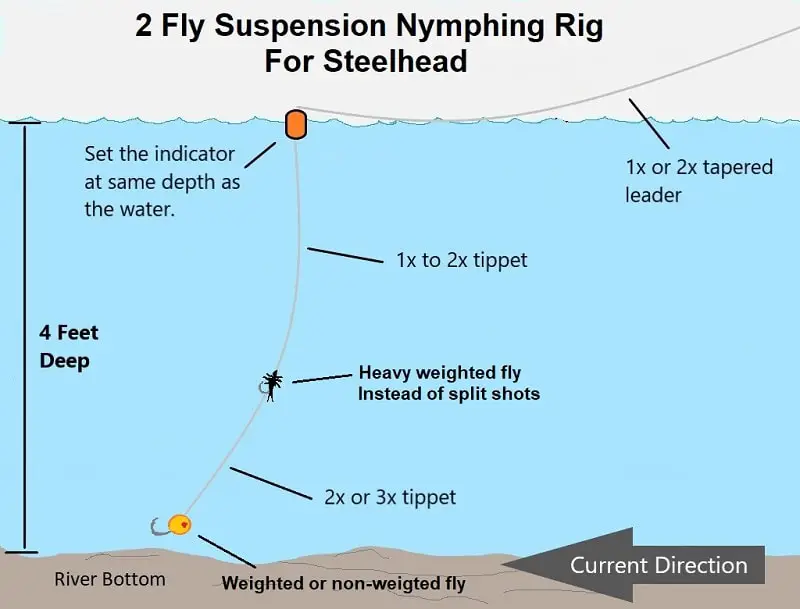
The “secondary fly” is a fly I want to test to determine if the trout or steelhead like it. However, some days, both flies will be very effective, and testing flies means I’m trying to determine two flies that work.
The secondary fly can be placed 6″ to 36 inches up the line and is almost always a different fly pattern, sometimes much different than my primary fly.
The test fly could be bigger, smaller, bushier, shaped differently, or it could just be a different color from my confidence fly. Almost always, it’s a different fly pattern with one exception.
Often, one of the flies I use is a fly that matches a recent or upcoming hatch to see how the fish react to it.
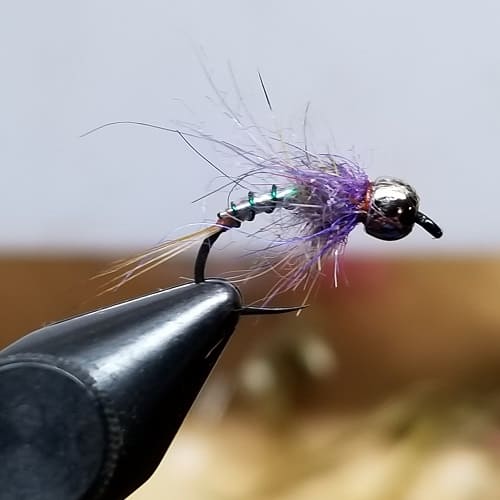
I already know that my confidence fly, which will be in the strike zone near the bottom, is an effective fly, so I will often test out new patterns on the top to see if the fish will eat it.
At times a client will open their box and ask me about their flies that they picked up at the local store.
I will often pick two or three out and try them as the top fly just to see if they work.
In fact, some of my most productive patterns have come from patterns of my clients.
I’m never afraid to try new flies when using a double fly rig because I know at least one fly will work.
If I’m in the process of testing out flies with the top fly, I will often keep the two flies closer together (which means they are around 12 inches apart) so that both flies are in the same strike zone.
If one fly keeps getting eaten, and the other one doesn’t I will swap out the fly that doesn’t get eaten with another pattern to test that new one.
If you put your test-fly 30 inches up the line, it could actually be a better fly than the confidence fly, but you won’t know for sure since it could be too high and too far out of the strike zone, so it may not get eaten. If this is the case, you won’t be able to determine if it’s a good fly or not.
This is why when I test out a new fly, I often keep it within 16 inches of the confidence fly and in the strike zone.
Determining Feeding Zones With A 2-Fly Rig
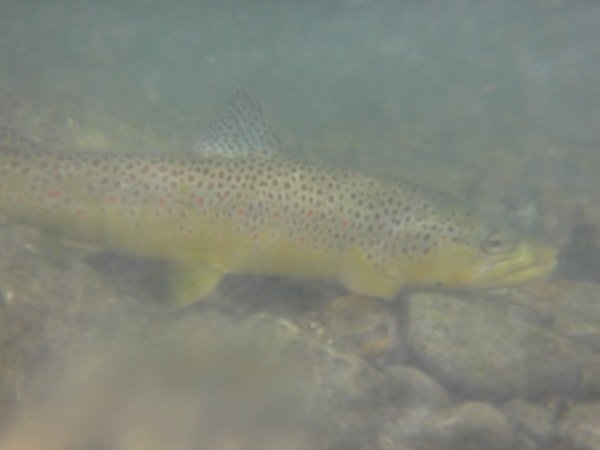
If I tested out both patterns and both patterns equally good, I will then make another adjustment by increasing the distance between the two flies to determine if there are fish feeding high in the water column.
A two-fly rig is a great way to help you determine if the fish are feeding close to the bottom or if they are looking up and feeding higher in the water column.
Once I have determined which flies are working, placing one fly near the bottom and moving the second fly 30 to 40 inches up the line is a great way to determine if they are feeding low or high in the water column at the same time.
When using two different flies on a two-fly setup, sometimes the fly on the top will get eaten the most. You need to understand why?
When one fly gets eaten more than the other, many of my clients will automatically assume that it gets eaten the most because that is the fly that the trout like. This is not always the case!
It could be true that they prefer one fly over another, but I also tell my clients that maybe it’s not that one fly is actually better than the other, it could simply be that the one fly that is being eaten the most, in this case, the top fly is getting eaten more only because it’s in the right spot at the right time.
If the fish are looking up or they are suspended off the bottom, then it only makes sense that a fly presented above them will be the one that gets eaten the most.
If I find that the top fly is getting eaten the most and I am using two different flies, I may experiment and switch the positions of the same two flies. I will put the bottom fly on the top and the top fly on the bottom. I do this as a test.
If the fish keep eating the same fly that was once on the top and the one they prefered, but is now on the bottom, then I know that it’s the fly they wanted and not the position of the fly in the water column.
But if the trout start eating the new top fly (the one that wasn’t getting eaten before because it was on the bottom) then I know it wasn’t the fly after all, instead it was just that they are feeding high in the water column.
As a guide and an angler, this is great to know because not only have I determined which flies are effective, I can fish both flies in the upper water column and keep fishing higher and maybe double my chances.
There have been days on the water when I have forced my client to nymph one fly 6 inches below the surface, and a second fly 20 to 30 inches below that, and it was fantastic.
I said “forced my client” because it’s very common for most anglers to want to only nymph their flies along the bottom, and this is often a HUGE mistake.
GUIDE TIP: A recent study I read claimed trout only feed downwards 13% of the time. To me, this means that 87% of the time trout move upwards or side to side to feed. So, if you drag your fly along the bottom, you will be missing potential fish!
I have proven this to my clients by having them fish a small section of the river for 5 minutes to see how many fish they can catch. I will then take their rod with the same fly, and I will fish the exact same stretch they just fished for 5 minutes. Almost always, I will catch 3 to 5 times more fish out of the same spot after they have already fished it.
All I have done differently than they did was control my fly depth and fish 12 to 20 inches off the bottom at all times. Basically, they dragged the bottom, and I knew it, and I simply kept my fly above the trout’s head as much as possible.
Guys, fish look up, not down, so stop dragging the bottom and keep your flies at eye level or just above the trout, and you will catch more fish.
When fishing steelhead and salmon, I tend to keep both flies 12 to 20 inches apart and both closer to the bottom.
The 2 Fly Cast
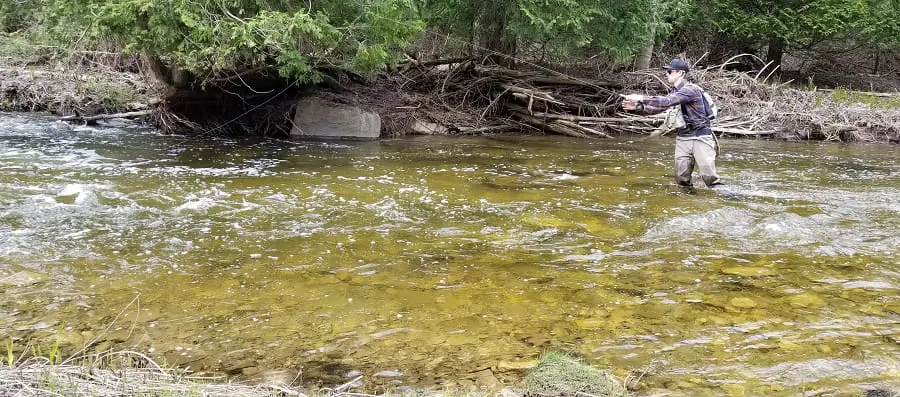
Casting a two-fly setup is not the same as casting a single fly. You need to cast a bit differently.
New anglers often tangle their leaders a lot more than more experienced anglers do when fishing two flies, this is not the fault of the 2-fly rig, it’s the fault of the angler.
I will fish a two-fly rig for days and days and not get a tangle. How I do this is by keeping my leader straight when it lands and by using a drag-and-flip type cast.
It’s not a fly cast at all. My leader comes out of the water straight, it stays straight in the air, and it lands straight. If you can do this, you won’t get tangled.
To do this well, start by flipping the fly down the river using a wide roll cast. With about 10 to 15 feet of fly line out of the end of the rod and straight down from you and tight from the current, slowly and smoothly lift the rod up and slightly behind you, and once the rod is almost straight up you flip all the line, the leader, and the two-fly setup up rive and out at about a 45-degree angle.
If you have done this well, your flies will have come up to the surface at the start of your cast, and your leader right to the flies will be straight, and your flies and leader will have landed in a straight line out or up the river from you.
If you are tangling up a lot, it means you have slack in the line at some point, probably in your cast or landing. If your two flies and the leader land in a pile with lots of slack in the leader, it can cause tangles, but if your leader lands straight, you will not tangle.
I tell my clients that it’s impossible to tie a knot in a straight line or a line that does not cross itself. If you learn how to keep your leader as straight as possible you will stop getting unwanted knots and tangles. In theory, it’s that simple.
Therefore, if you can pull the flies out on your cast with everything straight, and you can lob those flies overhead in as straight a line as possible, and you can then land everything straight on the water, then you will start to be able to fish for days without a tangle, just like I can.
This is hard to explain in words so I hope to have an update with a video of how to do this coming soon.
How To Fish A 2 Fly Setup
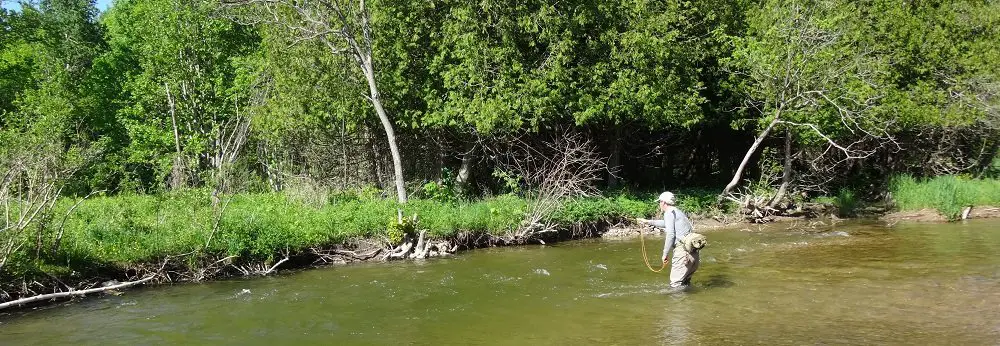
When I fish a two-fly rig, I either use a tight line (euro style) method with no indicator and no weights, or I might use a similar tight line rig with added weights on the line, but I fish these two methods the same.
The other method that I will use with a two-fly setup is to use an indicator.
Whether I use an indicator or not, I do not fish a two-fly nymph setup any different than a 1 fly rig.
The only thing I might do differently with a two-fly setup is I’ll be a little more careful with my casts so that I don’t tangle everything up, and my leader setup will be different. Otherwise, everything fishes the same as with a one-fly rig.
The only other thing that I might do is go with a bigger indicator that can handle the extra weight of a 2-fly rig.
Presentation Is Key

Just because you have two flies on the line doesn’t mean you will catch more fish. What catches more fish is being able to present the fly, or two flies exceptionally well.
There are many other factors that I teach my clients as well that will help you catch more. I highly suggest going to my page on Trout Fishing 101 – 3 Part Series
Advanced Nymphing
I recently added a special page called Fly Fishing Nymphs. This used to be a page that was private and just for my clients and my students from my advanced nymphing classes.
Most students claim that they start catching a lot more trout and steelhead after taking this advanced nymphing class, however, I often provide more information than they can absorb in one day, so I made this page as a summary of what I teach.
That page is most of the stuff that I include in my advanced nymphing classes and I update it every now and then. It also includes other two-fly rigs for you to check out.
Also, see my page The 4 Most Effective 2-Fly Setups For Nymphs That Guides Use.
Best of luck,
Graham
